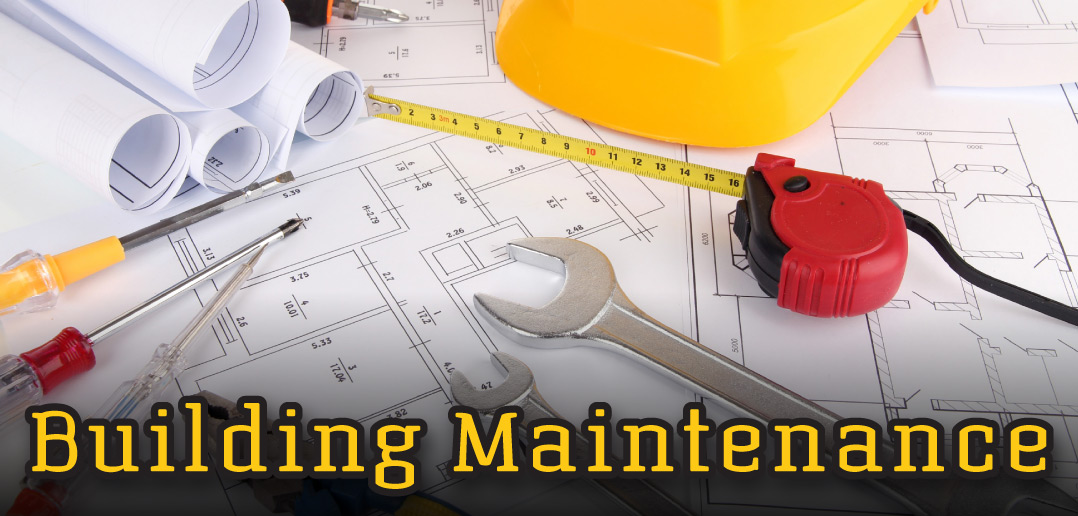Building Maintenance in Lincoln, NE – 2018
There’s little more important for a commercial property owner as well as for the occupants of a building, or tenants when applicable, than the proper building maintenance being performed on a regular basis. Ideally, if this is done correctly, business is conducted as usual and it goes without notice for the most part. However, on the other hand, if not kept up with as it should be, there are things that you will surely notice that are less than desirable, even dangerous and disastrous, for any number of reasons. This also translates into being more costly to repair or replace as opposed to protecting your investment and ensuring longevity by maintaining. There are a number of variables to consider that have an impact on the building environment and operations within it. A maintenance schedule is a must, whether you’re performing the tasks or outsourcing the work.
For property owners, some will have a full team of professionals dedicated to building maintenance while others will do some of the items themselves and contract out the others to trusted professionals with whom they have developed a working relationship. For tenants, while there are some things you may be responsible for based on your lease, generally the majority of the items will be performed by property management.
“We employ several individuals who provide routine maintenance for our tenants,” says Rick Krueger with Krueger Development. “These services include changing lights and furnace filters, plumbing calls, and other miscellaneous items. However, it is most important to be available for tenant emergencies, such as when the premises and/or equipment on site are damaged, which is most commonly as a result of bad weather. Tenants are likely to stay with you if they know you will provide timely servicing of their maintenance and repair needs. Especially in emergency situations – getting a tenant back up and running is key.”
Along the same lines, Michael Holroyd with HIP Realty (Holroyd Investment Properties) notes, “By investing in maintenance on the front end, businesses can save money in the long run. Besides the financial benefit, there is also the peace of mind that comes with knowing maintenance solutions are in place.
HIP Realty Property Management division is a full-service property management firm, offering personalized services to property investor/owners and their tenants. HIP Realty prides itself on providing star quality service.
HIP Realty’s property management team is able to provide a customized maintenance package for our owners or tenants to fit their business needs. Our property maintenance technicians not only deal with day-to-day issues, but also complete a scheduled preventative maintenance visit to avoid bigger maintenance issues.
In particular, HVAC units are a large financial investment. By completing routine preventative maintenance, we are able to extend the life and efficiency of these units. A preventative maintenance schedule can save money on utility bills over the course of the year.
We also focus on outdoor lighting and entry doors. The security of our tenants, and their employees and clients, is important. Regular preventative maintenance of the lighting, locks, and alarm systems can reduce security issues. HIP Realty’s Property Management Team is on-call 24 hours a day. When issues arise in these areas, we are able to secure the building quickly any time of day or night.
When a problem does arise, from a broken water pipe to a burnt out light bulb, our HIP Realty Property Management Team knows how to get the issue addressed quickly.”
Pertaining to HVAC, Keith McRoberts with Star City Heating & Cooling advises, “As many of you are well aware, your heating and cooling system is a major contributor to the wellbeing of your building and the overall comfort of your customers and employees. It’s what keeps pipes from freezing in the winter, the building from overheating in the summer, and the air clean year-round. Maintenance is so important to avoid issues that come along with extreme weather, which is when you rely on the heating and cooling equipment to function properly the most.
We conduct routine maintenance based on building requirements for heating, cooling, and ventilation systems which includes equipment, ductwork, air quality, and controls. Each building is unique in its requirements, so we inspect a building and develop a plan based on the needs of the building and the occupant. Some of the things would include filter replacement, system cleanings, and ensuring occupants have adequate temperature control throughout the space, along with many more that are evaluated on an individual basis.
Tenants, you should be aware of where the heating and cooling systems are located, which can be on the roof or inside, and where the thermostats and access points are located. This will help when relaying information for a service call or detecting if the sound is possibly coming from the HVAC system.
Also, keep in mind that it’s better to call sooner than later with a service repair need. A service repair may be needed if there are loud noises coming from the heating and cooling equipment, the air temperature is off by more than a few degrees of what is set on the thermostat, utility bills are abnormally high, or there are air quality concerns. Another issue to be aware of is any types of water leaks throughout the building. Water leaks can cause major damage if left unresolved.
It’s important to be clear on things such as:
- Are you responsible for scheduling maintenance or will the property owner/manager be in charge of setting up the maintenance appointment?
- If you are responsible for setting up maintenance appointments, what is needed to prove this was done?
- Is there a commercial maintenance plan already set up?
- If heating and cooling equipment replacement is needed, will you be responsible for sharing this cost?
- What is the protocol for requesting a service call when the building is too hot or cold? Is there a designated company to contact or should you call the property manager?
- If you’re responsible for making the service call, who is the point of contact with whom the technician can explain the diagnosis and estimate of repair costs?
Finally, if you’re purchasing a building, knowing the condition of the heating and cooling system, such as the year it was installed, how well it’s been maintained, and having a copy of the service history report will help with making the right realty deal.”
Based on his experience with commercial real estate transactions, Derek J Kats with Keller Williams Lincoln offers the following scenario he’s encountered and helpful tips to consider:
“As previously mentioned, building maintenance is one area that being proactive can save you from major mechanical breakdowns or excessive depreciation. In one of my recent building purchases, the building had a substantial amount of deferred maintenance. In particular, the elevator had not been serviced as routinely as it should have. Shortly after the purchase, the elevator went out. The initial concern was obviously the cost of the repair/replacement, but ultimately the loss of income for the building owners and occupants due to not being able to utilize the elevator took much more of a toll than the cost of the actual repair…which could have been prevented with proper building maintenance. To save you from similar issues, here is a basic list of items that should be checked or performed on a regular basis in order to keep your building functioning at all times.
- Fire Alarm and Sprinkler System Testing
- Sump Pump – Check Connections, Winding Motors, and Lubrication
- Water Pump – Domestic Water Circulating Pumps, Checks and Lubrication
- Dry Pipes – Air Compressor, Fire Compressor, Check for Leaks
- Garage Doors and Parking Gates – Lubrication, Adjustments of Beams, Pressure System Testing
- Exhaust, Supply and Return Fans – Motor, Belts and Barometer Testing, Air Flow Testing in Supply and Return Vents
- Elevator – Belt and Pulley Checks and Load Testing
- Winterization of Pipes
- HVAC: Coil Cleaning, Filter Replacement, Evaporator/Condenser Changing, Belts, Line Clearing, Amp and Ohm Motor Testing, Condensate Pipe Checks, Air Flow Testing, and Water Flow Testing
- Emergency Management Systems Operation and Testing
Should you have the need to buy or sell a commercial building, I offer services as a Realtor (and fellow property investor), from property acquisition and evaluation to leasing and sales, that can dramatically increase your chances of maximizing your business goals. For a free consultation, please call me at (402) HOMES-4-U or (402) 466-3748.”
To reiterate and expand, there are several instances where communication regarding building maintenance is important. Per what’s already been referenced, understanding the history of maintenance is imperative when a property changes hands. It’s also important for property owners and their employees and professionals contracted to perform maintenance to be on the same page. For property owners and tenants, it’s more about clearly defining who is responsible for what and bringing attention to any concerns as soon as possible.
“Each lease is different in the provision of tenant repairs and maintenance obligations,” explains Scott Bahm with NAI FMA Realty. “It’s common practice that a landlord maintains or repairs the building’s structure and mechanical systems while tenants take care of general interior maintenance. Tenants should bring attention to the building manager any structural, mechanical, or interior repairs or recurring maintenance issues. These can potentially cause extensive damage if left unattended. Building owners should periodically check any unoccupied or vacant spaces for leaks or other issues.
NAI FMA Realty is a full-service commercial real estate firm providing property management and facility maintenance for close to 4 million square feet of properties in Lincoln. We assist clients in every aspect of the property ownership life cycle and on any size of property. Our building engineers create efficiencies and cost savings while maintaining the asset to the highest standards.
The building’s systems and equipment are one of the most important aspects of a property to check. The heating and air systems in a building, in particular, are critical to the comfort and health of the occupants/tenants. By maintaining these properly, we are able to attract and retain quality tenants and maintain higher levels of tenant satisfaction. Every building or structure should institute a preventive maintenance program to not only maximize equipment value and prolong the life of the building and its systems, but help detect potential future issues and minimize the risk of damage.
Prioritizing maintenance, and repairs when needed, is key. Sometimes it’s easy to budget for aesthetic improvements; however, typically more dollars are spent on repairs you don’t anticipate through the year, so it’s wise to plan accordingly and invest in maintenance.”
When it comes to leveraging technology and related trends, he also notes, “Building managers having the ability to perform key actions remotely using web-based programs has been in use for some time now, and this technology continues to improve. The use of wireless technology, where systems communicate directly and automatically with other mechanical equipment to make adjustments and improve efficiencies, is on the rise. For example, a temperature sensor inside an HVAC system automatically adjusts for temperature and comfort as more people enter a space. As the industry rapidly evolves towards wireless operations, the biggest challenge is that controls are still predominantly hardwired.
Upgrading the building mechanical systems to incorporate a building management system or energy management system into the control and operation of equipment is very beneficial. In addition to regulating energy usage, it preserves the integrity of the building’s systems so they are operating as they were engineered and designed to perform.”
In agreement and expanding on this recommendation, Pat Killeen with Engineered Controls further advises, “Since Engineered Controls provides our customers with products for their buildings that serve the purpose of maintaining comfort, improving energy consumption, and providing a secure environment. Simply put, when it comes to our role in building maintenance, it is our job to make sure that the building’s mechanical and electrical control systems are functioning properly, as designed, and that everything is in good working order.
Building owners invest significant resources in environmental and building control systems. These systems can be costly to operate, yet essential for occupant comfort, productivity, and safety. Keeping systems operating at peak performance also reduces energy use and lowers utility costs, a growing concern for building owners worldwide.
Maintenance constitutes a significant percentage of expenses in most facilities and is therefore worth optimizing. Maintenance costs consume nearly as much of a typical building’s operating budget as utility costs and amount to more than one-third the total operating expenses.
Despite the importance and expense of maintaining building efficiency, most building owners, some 55% in the US alone, rely on reactive maintenance programs to care for their equipment. This means thy wait until equipment fails completely before initiating corrective action. Realistically, reactive maintenance is not maintenance at all and should be called repair work.
This leaves approximately 45% of building owners who take the traditional preventative maintenance approach, which means performing regular, prescheduled maintenance checks and minor repairs. This approach yields the best results.
When building owners ignore routine preventative maintenance, building occupants’ comfort can be negatively impacted whereby this can lead to employee absenteeism, low productivity, or even worse, becoming sick.
Furthermore, building owners could also see energy efficiency degraded by as much as 10% to 30% over a one- to three-year period. Beyond its impact on energy efficiency, lack of maintenance can lead to equipment failures where equipment replacements can drive up the unbudgeted cost of capital expenses. This can also disrupt employee or tenant comfort and lead to equipment issues that pose a safety risk in a building. Besides equipment failures, the lack of building maintenance can compromise indoor air quality and unnecessarily increase energy usage. These kinds of problems can get more expensive the longer building maintenance is ignored.
A more efficient way to incur minimal costs and achieve maximum availability is to implement a service plan that uses proactive and predictive maintenance based on the actual condition of the equipment rather than a predetermined schedule. With this approach, equipment is maintained at a continuously high level of performance rather than waiting for something to fail. In addition, a predictive approach can be used to prioritize repairs and maintenance so that the most important systems, as judged by the building owner, are repaired first, ensuring the most effective return on investment.
The most efficient approach is to include progressive analytics to leverage the big data generated by today’s advanced Building Management Systems (BMS). This data provides accurate, timely, and actionable information that can be leveraged to refine service programs even further and achieve optimal building performance. Building owners can make data-driven decisions based on the impact that the recommended maintenance will have on the efficiency of a building’s performance.
For example, in a predictive maintenance program, key operating parameters of equipment are checked regularly by staff or monitored automatically by BMS sensors. The readings are then analyzed and used to evaluate the condition of the equipment and predict the future performance or likelihood of failure. This means that repairs are performed at the ideal time, resources are not wasted on unnecessary work, and the equipment is maintained at a higher level of performance.”
While on the topic of improving the indoor environment, as well as enhanced energy efficiency, you might also consider installation of window films to help minimize the costs of future building maintenance. According to Keith May with The Tint Shop, some of the greatest features and benefits are:
Glare and Heat Reduction: “This increases the comfort of the building for all employees while reducing energy consumption and costs,” explains May. “3M Solar Control Films can cut the glare coming through the glass by over 85%; sometimes around 95% with the right kind of glass and film combination. They can be virtually clear, are safe for all glass, and also have the potential to reduce the heat coming through the glass by almost 70% while not changing the exterior or interior appearance of the glass at all. With these benefits, you’ll also reduce the strain on your building’s equipment, which protects your investment and extends longevity of its life cycle.
UV Protection: “All 3M films block 99% of UV light entering through the glass, which will keep flooring, woodwork, decorations, drapes, blinds and other interior furnishings from fading. Also, blocking UV rays can make an employee working in front of a window much more comfortable, and therefore more happy and productive,” May notes.
Improved Aesthetics: “You always want your building to look well-maintained, both inside and out,” May emphasizes. “When an exterior facelift becomes necessary, adding 3M Window Film is a relatively simple way to improve the appearance of the entire building. As far as interior decorating, 3M Fasara Frost Decorative Films are used in commercial spaces and offices to obscure vision into a certain room or area of the building, while still allowing natural light to come through the glass. Architects are on a big trend of adding a lot of glass in offices presently, and will be doing so for years to come. All of the glass helps open up an office environment immensely, as opposed to cubicles or walls. However, then privacy tends to become an issue, as well as concealing all the cords and wires from computers, phones, etc. These 3M Frost Decorative Films provide the cover needed to ‘clean-up’ those ugly areas under and behind desks, and in conference rooms, where privacy is sometimes needed. You won’t lose light in an area like you would with a dark black privacy film, and they do add a bit of décor and distinction to clear glass, which is a really nice touch.”
Safety & Security: On this topic, May expands on the importance of maintaining a safe and secure building. “We offer a full line 3M Safety and Security Films, the strongest on the market. The need for security films is not always an obvious one, but in certain situations, they are the perfect add-on. Whether it’s a retail store hoping to prevent ‘smash and grab’ thefts, a government building needing bomb-blast level protection from flying glass, or a school wanting to protect children and staff from possible violence, The Tint Shop has a vast amount of experience providing solutions for these concerns and many more. There are even a few 3M films in what’s called the Solar-Security line, which combine the heat and glare reduction of their Solar Control line with the unmatched strength and performance of their Safety/Security films. These films can be a bit pricey, but if you want to get the best out of one film, these films will fit the bill every time.”
3M Window Films also come highly recommended by The Skin Cancer Association, ASID, and are Energy Star Rated. If you think 3M Solar Control or Decorative Window Films may be right for your building or office, May suggests doing a little research online first. On The Tint Shop’s website, tintshoplincoln.com, you can find out more information, request an estimate, and even ask questions, which will be answered in a timely manner by a 3M certified professional. Or, check out The Tine Shop on social media: Facebook (search The Tint Shop), Twitter (@TheTintShopLNK), and Instagram (thetintshoplnk) to view past projects and see what’s new or being installed in other buildings across town and nationwide.
With much of building maintenance and repair being quite technical, even more so than one might think, it’s critical to carefully evaluate your options, and to involve a professional in that process. Their take on things and guidance when you’re making decisions about how best to handle it is invaluable.
To illustrate yet another excellent example of this, Steve Van Gorp with McGill Restoration discloses, “We specialize in restoration, which goes hand in hand with preservation. As such, we do a lot of work in buildings specific to structural integrity. With my extensive experience in the coating industry, I’ve seen the good, the bad, and the ugly. As such, I can fully attest to the importance of investing in the use of the proper methods and materials to maintain your building.
Specifically with anything that’s composed of structural steel, coating serves the purpose of protecting from corrosion. Parking garages, for example, are especially prone to accelerated corrosion given frequent traffic and along with it, heightened exposure to the deicing agents used on our roads. Given that it’s no longer just salt that is used, that’s only become more of a concern. The same holds true for any building components that are exposed to the elements and also equipment, and to protect other types of materials aside from structural steel.
Building maintenance plays a huge factor in the integrity of your building. If you’re not watching for areas of corrosion or using the proper types of paint to protect against that, you could be in trouble. Once there is noticeable bubbling, whether it’s on steel, concrete, or another surface, there’s a reason why the paint is letting go, and that reason can vary. Furthermore, it’s a little more technical than just slapping a coat of paint on it and calling it a day. Sure, it may look good for the time being, but it’s not fixing any underlying issues that could be getting worse. If allowed to compound into something major, you’ll eventually have to deal with it, at which point it will be much more complex of a project and more costly to have done. When people think of painting, they tend to think it’s as simple as going to the store, picking some up, and taking a few hours to get the job done. However, there’s science behind the coatings that should be used in certain circumstances. We work with many specialty manufacturers that have developed unique products for very specific conditions, such as coatings that hold up against 98% sulfuric acid, antimicrobial coatings, coatings that when applied with a professional sprayer dry in 10-15 seconds for ideal use on high-traffic buildings, and so on. Contractors make an investment in equipment and materials for a reason. We always want to provide the best options to our clients, and look into many different aspects from the testing behind it to its performance in the lab setting and in real life use.
Whatever the case, be wise with your maintenance decisions and hesitant about letting cost be the only factor that influences those. What’s least expensive now may prove to be more costly in the long run. In this case, a new coat of paint always looks nice, but oftentimes aesthetics is only one of multiple concerns that need to be addressed. I strongly encourage taking advantage of consulting with a professional when you notice something suspicious.”
Maintaining a clean and presentable place of business and work environment is equally as important as everything else we’ve covered thus far. It’s a simple and straightforward aspect of building maintenance that should be performed on a regular basis.
“Cleanliness matters,” emphasizes Teresa Hodgen with 360 Clean. “Your customers will notice how clean your building is, guaranteed. When it smells clean and looks clean it positively influences people’s decision-making. From the bathrooms and entries to the water fountain and baseboards–it all matters to your customers. When people visit your building or office and they don’t have a pleasant experience, that will be the first thing they tell their friends and it will spread quickly.
Hodgen advises, “Hire a good cleaning company that is reasonably priced and does quality work. As the owner of 360 Clean, it is my job, not yours, to make sure everything is done to my satisfaction and yours. It is my job to make any corrections before you even know about it. Your reputation and growth depend on how your customers rate their experience with you. If they walk in the door and it smells good and looks good it will affect their mood. But if it looks dirty, they may turn around and walk out, opting to do business with your competitor.
Whoever you hire to clean for you, make sure they represent themselves well as that’s a good indicator of the quality you can expect from them in other areas. Attention to detail is necessary. While they are cleaning they should have a uniform on, have good hygiene, proper clothing on and be able to speak correctly. It makes a difference. This is true especially if they are going to be in your building while you conduct business.”
Also a matter of cleanliness and maintaining hygienic facilities, but also extending into utility usage with respect to water, there will be different requirements if your building is in the city versus a remote location outside of it. “Septic systems are put in place when city sewer can’t be utilized,” says Jason Kubik with Southwick Liquid Waste. “As far as routine maintenance, septic tanks need to be pumped regularly. Some people choose to keep track of when it needs to be done and set those appointments accordingly, but many of our clients prefer to be on a maintenance contract. We come out every six months and check the laterals and tank and then pump it every three years. The hard part about septic maintenance is that tanks don’t need to be pumped but more than every 3-5 years based on activity level. This is very easy to forget or allow too much time to pass without realizing it.
When you have a new tenant in a building that has a septic system, remind them to be careful of water usage, to be careful with your toilet paper type (no wet wipes or quilted toilet paper products), and no flushing of any other product other than cheap, single ply toilet paper. Most toilet paper companies say they are septic safe, but the cheaper, lesser ply brands are the ones that work the best.
Most people don’t like to think about wastewater or toilets. I get it, it isn’t a pleasant subject. However, it is something that if not considered, can lead to expensive and disgusting issues. No one likes wastewater covering their floors or dealing with the mess a system that is not maintained can cause.
Along with regular maintenance, upgrades such as water-saving toilets are easier on your system, keeping it functioning longer.”
Also, especially in the case of restaurants, there is regular liquid waste disposal needs in the form of grease. Kubik summarizes, “For restaurants, we typically pump grease traps every 3-6 months depending on the restaurant and their volume of grease production. Grease isn’t something that should get out into the city sewer lines; therefore, ‘traps’ are placed in most kitchens to stop this. However, these traps need to be cleaned regularly or they can clog sinks and drainage lines for the restaurants too.”
There you have it, plenty of useful information to consider with respect to your current building maintenance and how it is well in hand versus how it could be improved. Take it from the experts and be sure to take your building maintenance seriously and stay on top of it.










